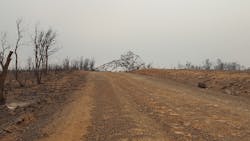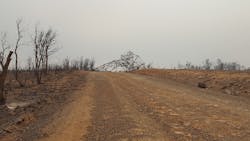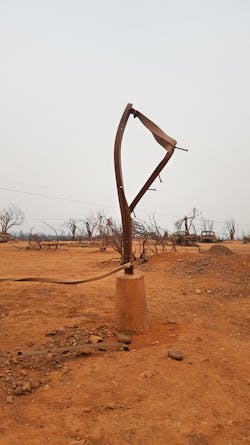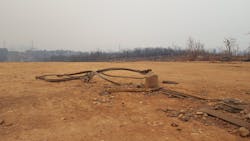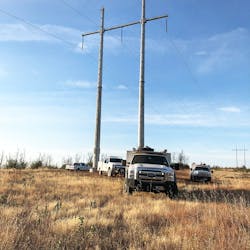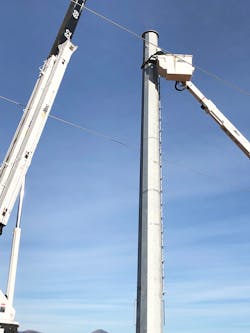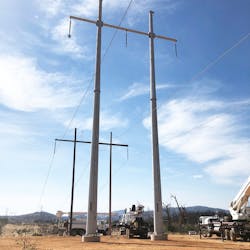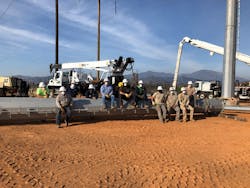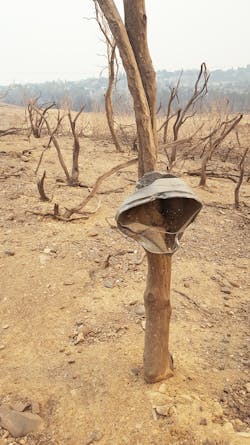Oftentimes, large forest fires are known to create their own wind and weather patterns. Whirlwinds of air and fire, called firenados, form near the edge of wildfires. Because they can quickly change direction, their movements are unpredictable, and their embers can rapidly spread wildfire to new areas.
For example, high winds associated with the Carr Fire firenado completely destroyed three Western Area Power Administration (WAPA) 230-kV transmission towers on two different lines between Shasta Dam and the Cottonwood Substation. The firenado also took down the conductor on Shasta-to-Flannigan line taking the circuit out of service. It knocked out WAPA’s north area infrastructure artery, directly or indirectly impacting operations across the northern system in the Sierra Nevada Region (SNR). The hardest hit area was near Keswick Dam to the northwest of Redding, California.
“Extreme heat mixed with high winds and cold air from the Sacramento River caused a firenado that resulted in catastrophic failure to everything in its path,” says Foreman II Lineman Ryan Yeager for WAPA.
Installing Temporary Structures
The Department of Energy described the firenado’s impact on one damaged line as “ripping the steel structures from the ground, resulting in tangled heaps of steel transmission towers, cars, trees and other debris.”
After the firenado subsided, WAPA’s SNR line crews worked around the clock to complete the repair job. Due to high costs and long lead times from manufacturers, steel lattice towers had a limited availability. Using temporary wooden H-frame structures immediately available in SNR yards, however, linemen worked to restore power as quickly as possible.
In emergency situations, WAPA usually responds with in-house maintenance crews. WAPA can also reach out to mutual assistance partners for help to restore power. At the time of the Carr Fire, however, contractors and mutual aid were not available due to the devastation to PG&E, the City of Redding and Shasta Lake City. As such, WAPA responded to the outages with its own maintenance crews.
“Within 24 hours, WAPA line crews had the Shasta-to-Flannigan line energized, restoring power to Keswick Substation,” Yeager says. “Within five days crews had cleaned up old towers, set new poles, strung wire and re-energized Shasta-to-Cottonwood 1 and 2.”
Preparing for Permanent Construction
Wood poles catch fire easily during intense forest fires and fall due to high winds dropping the conductor. This can cause a domino effect, toppling over poles and damaging lines. Steel lattice tower structures, which are predominantly used across WAPA’s SNR transmission system, are for the most part fire-resistant due to their all-steel construction. In the case of the Carr Fire firenado, however, the combination of extreme heat and high winds, comparable to an EF3 tornado, caused the steel lattice structures to suffer catastrophic failure.
In September 2020, linemen installed three permanent 100-ft tubular steel tower H-structures to match the height of the original lattice structures. But in the meantime, to keep wire height within NERC standards, WAPA used four temporary wooden spar-arm H-structures in place of three steel lattice towers destroyed in the blaze. Poles ranged from 70 ft to 90 ft tall. Engineers determined the proper wire heights, which dictated the temporary wooden H-structure height. Four H-structures were used in place of three towers to keep wire height up.
“The biggest challenge, besides the time crunch, was that we needed to keep the wire height up because of homes and driveways in the immediate area,” Yeager said.
This style of construction is standard practice for temporary restoration because of its ease of construction and the availability of materials.
“This approach to temporary construction can be used on both transmission and distribution systems, making it the go-to in the industry,” Yeager said.
Lessons Learned
Throughout the restoration and rebuilding process, the dedication and professionalism of WAPA’s staff members at all levels ensured the success of its response to the wildfire and firenado.
“The Emergency Operations Center model worked well, and the ability to track and communicate real-time events was instrumental in our swift and strategic actions, which ensured our customers’ interests were protected,” says Field Maintenance Manager Steve Tuggle.
In addition, the operational support for the field crews, which ranged from addressing travel needs and purchasing equipment to arranging restoration schedules, was instrumental and resourceful.
“After the Carr Fire, SNR had several meetings to acknowledge what worked well but also to discuss and develop areas for improvement,” Tuggle says. “As a result, we have a summary and debriefing document that describes and tracks the actions to improve our response readiness moving forward.”
Looking Ahead
SNR’s approach to wildfire mitigation is to manage the electric system in a safe and reliable manner that minimizes the risk of wildfire posed by its electrical lines, substations, communication sites, compensation station and related equipment. Over the years, SNR has developed and operated a robust and effective maintenance program, says SNR’s Vegetation Management and Access Roads Specialist Ricardo Velarde.
“Wildfire impacts continue to grow from year to year in California,” he says. “In response, SNR has identified potential wildfire risks and consequences within its service area and developed response strategies, which we have implemented region-wide while prioritizing activities within elevated fire risk areas identified by the state.”
SNR supplemented its maintenance personnel to conduct focused transmission line and right-of-way (ROW) inspections and document fuel-load concerns. In addition, WAPA developed special inspection plans for equipment in elevated fire risk-areas where crews climb and inspect every tower for structural and equipment issues. The team performs a close visual inspection of the tower looking for any loose steel, bolts on the ground or any other aberrant condition.
SNR has expanded the use of infrared and corona cameras for early identification of potential structural, equipment and related failures. In addition, SNR is increasingly relying upon LiDAR, high-definition video, orthophotography and still imagery to develop a baseline for in-ROW and off-ROW conditions and to identify potential vegetation encroachments near powerline conductors. Through these proactive strategies and best practices from previous events, WAPA is ready to respond to future wildfires in its service territory.
By the Numbers
The Carr Fire was the seventh most destructive wildfire in California’s history. Here are some other statistics, according to WAPA’s Closed Circuit and the Department of Energy (DOE).
- 38,000 evacuations.
- 229,651 acres were affected.
- 1,604 buildings were destroyed.
- 11 injuries and eight deaths.
- 10 WAPA structures were down and 15 115-kV and 230-kV lines, 6 substations, and 13 hydroelectric generators were out of service as a result of the Carr Fire, according to the DOE.
About the Author
Amy Fischbach
Electric Utilities Operations
Amy Fischbach is the Field Editor for T&D World magazine and manages the Electric Utility Operations section. She is the host of the Line Life Podcast, which celebrates the grit, courage and inspirational teamwork of the line trade. She also works on the annual Lineworker Supplement and the Vegetation Management Supplement as well as the Lineman Life and Lineman's Rodeo News enewsletters. Amy also covers events such as the Trees & Utilities conference and the International Lineman's Rodeo. She is the past president of the ASBPE Educational Foundation and ASBPE and earned her bachelor's and master's degrees in journalism from Kansas State University. She can be reached at [email protected].
